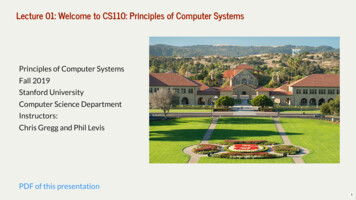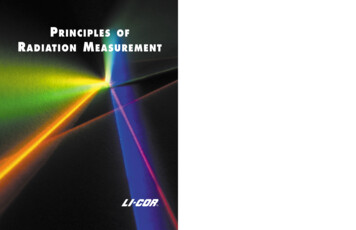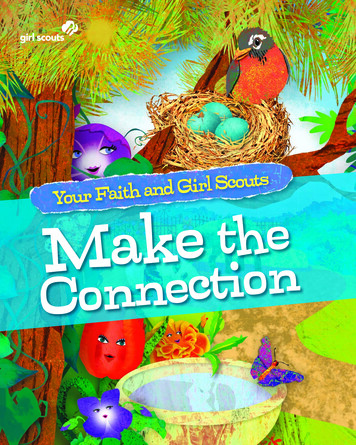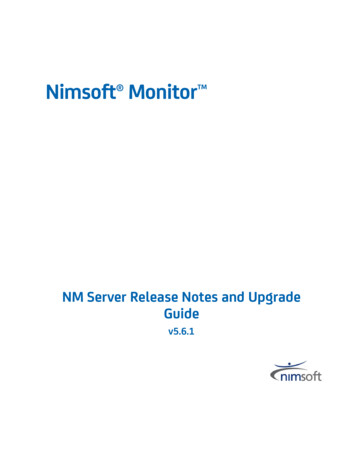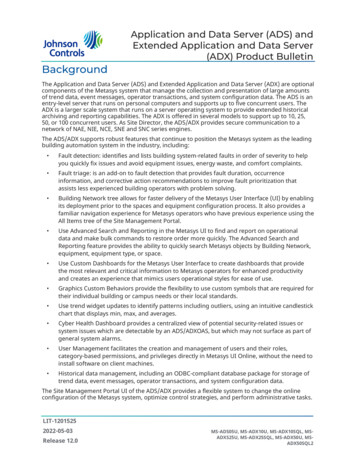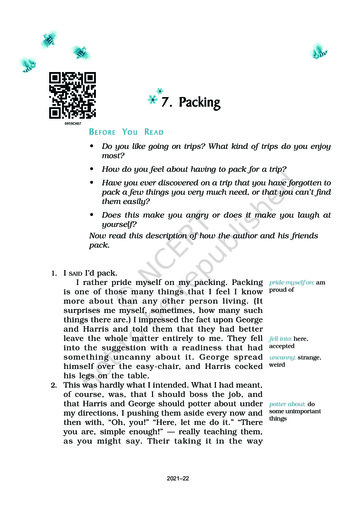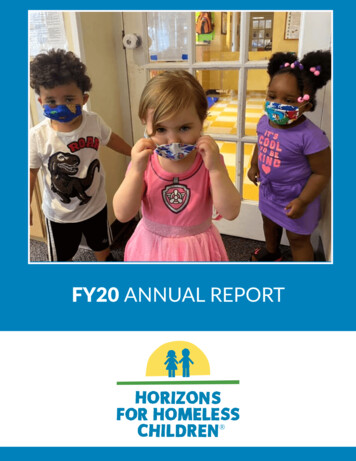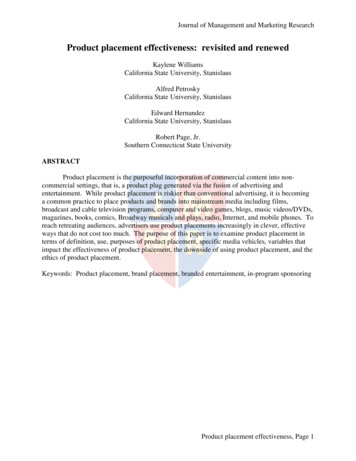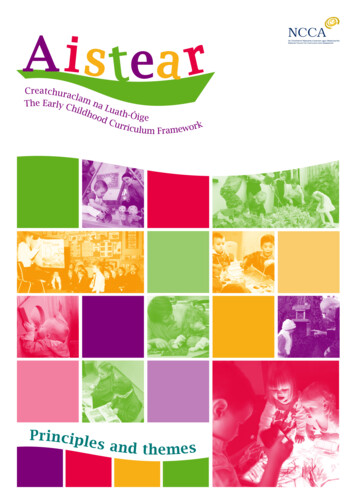
Transcription
Principles and themes
NCCA 2009National Council for Curriculumand Assessment24 Merrion Square, Dublin 2.www.ncca.ie
Aistear: the Early Childhood Curriculum FrameworkA Message from the Minister for Education and ScienceThe publication of Aistear: the Early Childhood Curriculum Framework marksan important milestone in early childhood education in Ireland. Building onother important developments in the sector, Aistear is the outcome of many yearsof research, consultation, planning, and development by the National Council forCurriculum and Assessment (NCCA) in partnership with the early childhood sectorin Ireland and abroad. This partnership has enabled the Council to develop acurriculum framework which reflects the experiences of practitioners, children andparents and is informed by evidence and research.The Irish word for a journey, Aistear represents the beginning or perhaps the further advancement of anexciting journey for many; for parents in children’s own homes and practitioners including childmindersand infant teachers in the variety of out-of-home settings as they begin to use Aistear’s contents, and forchildren as they embark on their lifelong journey of learning and development. The framework highlightsthe critical importance of children enjoying and benefiting from early childhood, and its potential adventuresand discoveries. It also illustrates the breadth and depth of children’s learning when given rich and variedexperiences in their formative years. In addition, it highlights the important role adults play in nurturing andextending this learning and development. I am confident that such a curriculum framework can contributegreatly to helping our youngest citizens grow up with a strong sense of well-being; proud of themselves, theirfamilies and communities; confident and competent communicators; curious and resilient explorers; andcreative thinkers.I would like to thank the NCCA for its leadership in this work and the many organisations, agencies andresearchers who contributed to the development of Aistear. Particular thanks are due to the practitionersaround the country who offered their views and insights as the work progressed. I look forward to thecontinuing journey of bringing the aspirations of the framework to the everyday practice of all who workwith children from birth to six years.Batt O’Keeffe T.D.Minister for Education and Science3
Aistear: the Early Childhood Curriculum FrameworkA Message from the Minister for Childrenand Youth AffairsEarly childhood is an important stage in children’s lives when they find out aboutand make sense of their surroundings by interacting with each other and with adults,by playing, exploring, and by forming and testing ideas. Aistear: the Early ChildhoodCurriculum Framework highlights this tremendous capacity that children have tolearn and develop, and the importance of everyone working together to give childrenrich experiences in these early years.The introduction of the Pre-School Year in Early Childhood Care and Education is asignificant move forward in our collective journey of continuous quality improvementin the sector. In particular, it marks a key step towards equality of opportunity for all young children inIreland at the most important developmental stage of their lives. I welcome the timely publication of Aistearand am confident that, together with Síolta, the National Quality Framework for Early Childhood Education,it can provide much practical support and guidance to practitioners participating in the initiative, and tothose working with younger and older children in the early childhood period. Aistear’s intended outcomesfor children are especially fitting in a 21st century society and provide an exciting and challenging vision towhich we can aspire in our work with children from birth to six years.I would like to record my thanks to the NCCA for its work on Aistear, and to the early childhood sector forthe ongoing contribution to the framework. I know Aistear will be welcomed by the sector and will have asignificant influence on the development of early childhood practice in the years ahead, ultimately enrichingthe lives of our youngest citizens.Barry Andrews T.D.Minister for Children and Youth Affairs4
Aistear: the Early Childhood Curriculum FrameworkContentsIntroduction6Principles of early learning and development7Aistear’s themes13Theme: Well-being16Theme: Identity and Belonging25Theme: Communicating34Theme: Exploring and Thinking43Glossary53FiguresFigure 1: Describing children’s learning and development through themes13TablesTable 1: Aims and learning goals for Well-being17Table 2: Aims and learning goals for Identity and Belonging26Table 3: Aims and learning goals for Communicating35Table 4: Aims and learning goals for Exploring and Thinking445
Aistear: the Early Childhood Curriculum FrameworkIntroduction and principlesIntroductionEarly childhood is a time of great opportunity for learning and development. In these early years childrenlearn through loving, trusting and respectful relationships, and through discussion, exploration and play.They learn about languages and how and when to use them; they learn to think and to interact with othersand the environment. They learn to be creative and adventurous, to develop working theories about theirworld, and to make decisions about themselves as learners.Aistear: the Early Childhood Curriculum Framework celebrates early childhood as a time of being, and ofenjoying and learning from experiences as they unfold. This early learning also lays important foundationsfor later learning. Because early childhood marks the beginning of children’s lifelong learning journeys, thisframework is called Aistear, the Irish word for journey.Purpose of AistearAistear is the curriculum framework for children from birth to six years in Ireland. It provides informationfor adults to help them plan for and provide enjoyable and challenging learning experiences, so that allchildren can grow and develop as competent and confident learners within loving relationships withothers. Aistear describes the types of learning (dispositions, values and attitudes, skills, knowledge, andunderstanding) that are important for children in their early years, and offers ideas and suggestions as tohow this learning might be nurtured. The Framework also provides guidelines on supporting children’slearning through partnerships with parents, interactions, play, and assessment.In supporting children’s early learning and development Aistear identifies what and how children should learn, and describes the types of experiences that can supportthismakes connections in children’s learning throughout the early childhood years and as they move fromone setting to anothersupports parents as their children’s primary educators during early childhood, and promotes effectivepartnerships between parents and practitionerscomplements and extends existing curriculums and materialsinforms practice across a range of settings, disciplines and professions, and encourages interdisciplinarywork.6
Aistear: the Early Childhood Curriculum FrameworkIntroduction and principlesPrinciples of early learning and developmentAistear is based on 12 principles of early learning and development. These are presented in three groups:1.The first group concerns children and their lives in early childhood:2. the child’s uniqueness equality and diversity children as citizens.The second group concerns children’s connections with others:3. relationships parents, family and community the adult’s role.The third group concerns how children learn and develop: holistic learning and development active learning play and hands-on experiences relevant and meaningful experiences communication and language the learning environment.Each principle is presented using a short statement. This is followed by an explanation of the principle fromthe child’s perspective. This explanation highlights the adult’s role in supporting children’s early learning anddevelopment.1.Children and their lives in early childhoodThe child’s uniquenessEach child has his/her own set of experiences and a unique life-story. He/she is an active learner growingup as a member of a family and community with particular traditions and ways of life. Remember that I am a unique individual with my own strengths, interests, abilities,needs and experiences. Recognise and build on these when you are helping me to learnand develop.You know I am a confident and able learner and that I learn at my own rate aboutthings that interest me. Support me to do this in a way that allows me to make decisionsabout what I learn and when, and how well I am learning.I need you, my parents and practitioners, to share what you know about me with eachother. By doing this, you can get to know me better and plan things for me to do thatwill help me to learn in an enjoyable and meaningful way.In order for you to understand and support me you need to understand my familybackground and community. This is especially important if I come from a disadvantagedor marginalised community.7
Aistear: the Early Childhood Curriculum FrameworkIntroduction and principlesEquality and diversityNurturing equality and diversity is important in early childhood. Promoting equality is about creating afairer society in which everyone can participate equally with the opportunity to fulfil his/her potential.Diversity is about welcoming and valuing individual and group differences, and understanding andcelebrating difference as part of life. Support me to feel equal to everyone else and do not let me be excluded becauseof my ethnicity, culture, faith/no faith, home language, family background and type,special educational need, physical appearance, gender, or ability. Recognise, value andaccept me and my family.You may have to treat me in a different way to other children,to ensure I feel equal. Thank you for respecting my culturalidentity and that of my family. Remember too that I may need youto help me to integrate into life in Ireland.Help me to learn to value social and cultural difference and torecognise that I live in a diverse, multi-ethnic society. Help me tolearn to recognise and challenge injustice and discrimination andto stand up for myself and others.Remember that learning is more meaningful, motivating and enjoyablefor me when activities and experiences are based on my skills,strengths and interests and when they are linked to my home cultureand language.Help me to be open to the ideas, stories and experiences of others, andto listen and learn from these.Children as citizensChildren are citizens with rights and responsibilities. They have opinions that are worth listening to, andhave the right to be involved in making decisions about matters which affect them. In this way, they havea right to experience democracy. From this experience they learn that, as well as having rights, they alsohave a responsibility to respect and help others, and to care for their environment. Remember that I too am a citizen. Help me to learn about my rights and responsibilities.Model fairness, justice and respect when you interact with me and others.Create an environment for me in which I feel confident and comfortable, and haveopportunities to share my experiences, stories, ideas, and feelings. Model democracyin action. Involve me in making decisions and in planning activities, and doing andreflecting on them with others.Let me share my views and opinions with you about things that matter to me. Help meto understand that others may have different views and opinions, and to respect these.As I communicate in different ways, this might mean you need to observe and interpretmy facial expressions, body movements, gurgles, cries, moods, and my language(s).I have the right to be protected from harm. Help to ensure I am not endangered orneglected. If you have concerns report them to the relevant person.Encourage me to care for my own and others’ belongings and for the environment.8
Aistear: the Early Childhood Curriculum FrameworkIntroduction and principles2. Children’s connections with othersRelationshipsChildren have a fundamental need to be with other people. They learn and develop through loving andnurturing relationships with adults and other children, and the quality of these interactions impacts ontheir learning and development. Show me respect and love when you talk to me; play with meand care for me.My early interactions with people lay the foundations for myrelationships with others later in my life. Help me make strongattachments and give me time and space to be with familiar,loving adults and with other children.I enjoy being with adults and children. Give me opportunitiesto play with them and to take part in activities with them. Help me to interactwith them, to have fun, to share, to take turns, and to handle conflict.Parents, family and communityParents are the most important people in children’s lives. The care and education that children receivefrom their parents and family, especially during their early months and years, greatly influence theiroverall development. Extended family and community also have important roles to play. Remember that my parents and my family are the most important people in my life.Value their opinions and expertise. Without the care and education I getfrom them I would not be who I am. They love me, look after me, andteach me important things about life and learning. They want the best forme. Give my parents opportunities to share information with you aboutme and about what I do at home.You, my parents and practitioners, need to work together to help melearn and develop to the best of my ability. Think about ways to makelinks between my home and where I spend time with you, because youare all important to me.My community is important to me too. Show through your interactionswith me that you respect my family and where I come from.The adult’s roleEarly learning takes place through a reciprocal relationship between the adult and the child – sometimesthe adult leads the learning and sometimes the child leads. The adult enhances learning through arespectful understanding of the child’s uniqueness. He/she alters the type and amount of support as thechild grows in confidence and competence, and achieves new things. Build a strong relationship with me and help me to trust you. If I feel happy and securewherever I am I will learn more.Think about how you help me learn. Make time to learn new things and new ways ofhelping me to learn and develop. That way we can learn things together.9
Aistear: the Early Childhood Curriculum FrameworkIntroduction and principlesBe a good role model for me, and think about your own beliefsand attitudes and how you interact with me. What you say, do andsuggest through your words and actions influences me. You play a key role in helping me to reach my full potential. Buildon my abilities, interests and experiences. Think of the differentways I learn and develop and use different interaction strategiesthat suit me. Sometimes parents find it hard to cope. When things go wrongin my family I need you to look out for me and to protect mefrom harm. Help me if I am being hurt because other children or familiesdo not understand my background or culture. 3.How children learn and developHolistic learning and developmentChildren learn many different things at the same time. What they learn is connected to where, how andwith whom they learn. I learn lots of things at the same time. Think about all areas of my learning anddevelopment—cognitive, creative, emotional, linguistic, moral, physical, social, andspiritual, and provide me with opportunities in all of these areas.When supporting me to learn and develop, remember that what I learn in my earlychildhood setting is shaped by previous learning and experiences with my family and mycommunity and as part of a wider society.Take time to observe me and to talk to me regularly. Use this time to identifymoments when you can help me connect my new learning and development with pastexperiences and plan for my future learning.Active learningActive learning involves children learning by doing things. They use their senses to explore and workwith the objects and materials around them and they interact enthusiastically with the adults andother children that they meet. Through these experiences, children develop the dispositions, skills,knowledge, and understanding, attitudes, and values that will help them to grow as confident andcompetent learners. Let me explore, try out, make mistakes, discover, and createmy own theories about how things work and why, so that I canbe independent and self-reliant and can learn about the worldI live in.Give me opportunities to use my different senses when I amlearning.Support me in learning with and from adults and otherchildren. Ask me about my discoveries and adventures; talk tome and help me to learn more. I learn a lot on my own but Ialso learn a lot when I can share my experiences with others.10
Aistear: the Early Childhood Curriculum FrameworkIntroduction and principlesPlay and hands-on experiencesMuch of children’s early learning and development takes place through play and hands-on experiences.Through these, children explore social, physical and imaginary worlds. These experiences help themto manage their feelings, develop as thinkers and language users, develop socially, be creative andimaginative, and lay the foundations for becoming effective communicators and learners. Play is important to me, and it is important for my learning and development. WhenI play, I use my body, my mind, my feelings, and my senses. Give me opportunities todevelop my play. Watch how I play, and see how you can support me.Give me time and space to play with other children. When I play with them I learn aboutco-operation, about how to deal with conflict, about how others think and feel, andwhat different actions and things mean. Sometimes I like to play on my own or withother children, and at other times I like you to play with me. You can help me to learnall sorts of things when we play together.Provide me with objects, toys and equipment that reflect my own and others’ cultures.I also need access to open-ended materials, natural and everyday things to help melearn. Let me experience the different types of play and encourage me to use all thematerials in the environment regardless of my gender or ability.Involve me in lots of meaningful, hands-on experiences in order to learn, to develop,and to become independent. I use my hands, my ears, my eyes, and my body to explorethe objects, places and people in my world. Allow me the freedom to explore and todo things for myself.Relevant and meaningful experiencesRelevant and meaningful experiences make learning more enjoyable and positive for children. On-goingassessment of what children do, say and make, and reflection on these experiences helps practitionersto plan more developmentally appropriate and meaningful learning experiences for children. This alsoenables them to improve their practice. Assessment is about building a picture of children’s individualstrengths, interests, abilities, and needs and using this to support and plan for their future learning anddevelopment. Look at what I am doing, talk to me and listen to what I am saying.When I master something for the first time, take a picture of me ormake a note of it and add it to my learning portfolio.Notice what I am interested in and what I can do. Record my progressand achievement in developing dispositions, attitudes and values,skills, knowledge, and understanding. This will help you to support myidentity, respond to my changing abilities, interests and needs, and planexperiences which will enhance my learning and development.My parents and family have lots of information about me andthey are interested in finding out what I do when I am not athome. They like to know how I get on with adults and otherchildren, what I am interested in, what I can do, and how theycan help me to learn and develop further. I need you, myparents and my practitioner, to make time to discuss how I amgetting on. Sometimes I will need you, my practitioner, to showmy parents what they can do to support my learning at home.11
Aistear: the Early Childhood Curriculum FrameworkIntroduction and principlesCommunication and languageThe ability to communicate is at the very heart of early learning and development. Communication helpschildren learn to think about and make sense of their world. They communicate from birth using manydifferent ways of giving and receiving information. Each of these ways is important in its own right.Learning to communicate in early childhood is shaped by two main factors: children’s own ability andtheir environment. Support me to communicate to the best of my ability from the earliest age possible.Watch out in case I have any communication and/or language delays or difficulties, sincethe earlier I get help the better it is for me.Remember that I give and receive information in many different ways. I cancommunicate using words, sign language, Braille, rhythm, number, movement, gesture,drama, art, and Information and Communications Technology (ICT). When I am ready,support me in my writing and reading in a way that suits my needs best, and don’trush me.You have a key role in supporting my communication and language skills. Talk to me,listen to me, respond to me, interpret what I say, and provide a place for me where Iget the opportunity to share my experiences, thoughts, ideas, and feelings with others inall the ways that I can. Model communication and language skills for me.My parents will be keen for me to learn English and/or Irish if I have a differenthome language. Remember to tell my parents that it is important for me to maintainmy home language too. Reassure them that I can learn English and/or Irish as well askeeping my home language.The learning environmentThe learning environment (inside and outside) influences what and how children learn. An invitingenvironment encourages and helps children to explore and to take advantage of opportunities for fun,choice, freedom, adventure, and challenge. I learn best in a place which is warm and inviting, acknowledges my familybackground, and makes me feel welcome and safewell-kept, accessible, adaptable, and safewell-resourced and well-organisedstimulating, challenging and empowering.Create this environment for me. The place where I learn and develop should support mydeveloping sense of who I am and how I belong to my group, myfamily, and my community. Make sure I can see and experiencelots of real and accurate reflections of my culture and identityas well as that of all the children who are with me – songs andstories, pictures and words, play and games.Set up and arrange the place where I play and learn so that it allows me to expressmyself, to interact with others, to make choices, to test ideas and materials, tocreate, to develop and practise skills, to stimulate curiosity, to foster empathy andindependence, to explore and make discoveries, to solve problems, and to persevere inthe face of difficulties and uncertainties.12
Aistear: the Early Childhood Curriculum FrameworkThemesAistear’s themesAistear: the Early Childhood Curriculum Framework presents children’s learning and development using fourthemes. These are: Well-being Identity and Belonging Communicating Exploring and Thinking.The themes describe what children learn—the dispositions, attitudes and values, skills, knowledge, andunderstanding. Each theme begins with a short overview of its importance for children as young learners. Thetheme is then presented using four aims. Each aim is divided into six learning goals. (See Figure 1.) Some ofthese goals may be more suited to children as they get older.Figure 1: Describing children’s learning and development through themes13
Aistear: the Early Childhood Curriculum FrameworkThemesEach theme offers some ideas and suggestions for the types of learning experiences that adults might providefor children in working towards Aistear’s aims and goals. These ideas and suggestions are known as samplelearning opportunities. They are presented in three overlapping age groups: babies (birth to 18 months) toddlers (12 months to 3 years) young children (2½ to 6 years).While most of the sample learning opportunities can be adapted and developed for different types ofsettings, some may be more suited to one type than to another. Most of the sample learning opportunitiescan also be adapted for use indoors or outdoors. Using the outdoor environment can often give childrenmore space and freedom to move, to explore, and to express themselves, which in turn can bring even greaterenjoyment, satisfaction and learning.14
Well-being
Aistear: the Early Childhood Curriculum FrameworkWell-beingTheme: Well-beingThe theme of Well-being is about children being confident, happy and healthy.Well-being focuses on developing as a person. It has two main elements: psychological well-being (includingfeeling and thinking) and physical well-being. Children’s relationships and interactions with their familiesand communities contribute significantly to their sense of well-being. Children need to feel valued, respected,empowered, cared for, and included. They also need to respect themselves, others, and their environment.They become positive about themselves and their learning when adults value them for who they are andwhen they promote warm and supportive relationships with them. Expressing themselves creatively andexperiencing a spiritual dimension in life enhances children’s sense of well-being. Life is full of challengesand struggles. Therefore, being flexible and having a positive outlook on learning and on life is crucial. Allthese experiences help children to become resilient and resourceful and to learn to cope with change andsituations in which things go wrong.Physical well-being is important for learning and development as this enables children to explore, toinvestigate, and to challenge themselves in the environment. A growing awareness of their bodies andabilities is also part of this. The adult supports children’s psychological and physical well-being by helpingthem to make healthy choices about nutrition, hygiene and exercise. He/she plans for and providesopportunities for children to express themselves, to encourage them to play and work with others, and todeal with challenges. The adult also helps children towards independence by providing them with choice intheir activities, and by providing opportunities for them to make decisions and to take the lead.16
Aistear: the Early Childhood Curriculum FrameworkWell-beingTable 1: Aims and learning goals for Well-beingWell-beingAimsLearning goalsAim 1Children will be strongpsychologically and socially.In partnership with the adult, children will1. make strong attachments and develop warm and supportive relationships withfamily, peers and adults in out-of-home settings and in their community2. be aware of and name their own feelings, and understand that others mayhave different feelings3. handle transitions and changes well4. be confident and self-reliant5. respect themselves, others and the environment6. make decisions and choices about their own learning and development.Aim 2Children will be as healthy andfit as they can be.In1.2.3.4.5.6.partnership with the adult, children willgain increasing control and co-ordination of body movementsbe aware of their bodies, their bodily functions, and their changing abilitiesdiscover, explore and refine gross and fine motor skillsuse self-help skills in caring for their own bodiesshow good judgement when taking risksmake healthy choices and demonstrate positive attitudes to nutrition, hygiene,exercise, and routine.Aim 3Children will be creative andspiritual.In1.2.3.4.5.6.partnership with the adult, children willexpress themselves creatively and experience the artsexpress themselves through a variety of types of playdevelop and nurture their sense of wonder and awebecome reflective and think flexiblycare for the environmentunderstand that others may have beliefs and values different to their own.Aim 4Children will have positiveoutlooks on learning andon life.In partnership with the adult, children will1. show increasing independence, and be able to make choices and decisions2. demonstrate a sense of mastery and belief in their own abilities and displaylearning dispositions, such as determination and perseverance3. think positively, take learning risks, and become resilient and resourcefulwhen things go wrong4. motivate themselves, and welcome and seek challenge5. respect life, their own and others, and know that life has a meaning andpurpose6. be active citizens.17
Aistear: the Early Childhood Curriculum FrameworkWell-beingSample learning opportunitiesBabiesThe adult engages with babies in a consistent, calm, caring andrespectful manner: knows babies well, responds appropriately to them and providesa secure base from which they can play and explore communicates positively with babies using eye contact, touch, and a soft toneof voice sets up relaxed routines for feeding, toileting, sleeping and play activities, andinteracts with and talks to the babies during these routines has routines for change-over and transition times, for example waving bye-bye,placing a favourite toy in a ‘special’ place, saying the babies’ names on arrival shares information regularly to get to know more about babies’ home andout-of-home experiencesenables babies to explore and manipulate objects in a multisensorial way so that they can smell, taste, hear, see, touch, reach,grasp, lift, and drop objects: provides a varie
themes 13 Theme: Well-being 16 Theme: Identity and Belonging 25 Theme: Communicating 34 Theme: Exploring and Thinking 43 Glossary 53 Figures Figure 1: Describing children's learning and development through themes 13 Tables Table 1: Aims and learning goals for Well-being 17 Table 2: Aims and learning goals for Identity and Belonging 26

